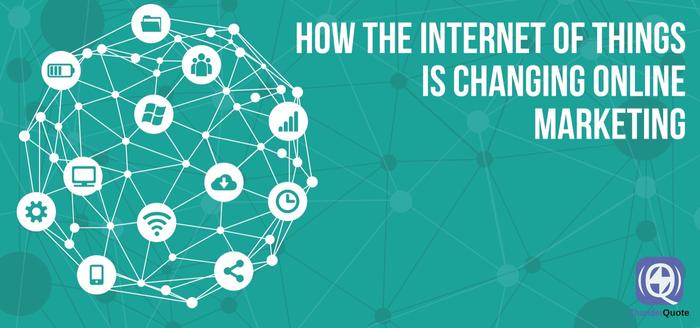The Internet of Things (IoT) refers to a phenomenon and an entity. It refers to the way Internet connectivity has expanded to include everyday objects and to how those everyday objects interoperate with our daily lives.
No longer do we “access” the Internet. The Internet is ever-present. It operates as an automated entity that can carry out functions that reflect and affect the physical world. We conduct business, live our lives, and dictate our affairs in its presence and based on its rules. Anything from your refrigerator to your key fob could be connected.
Forbescontributor Jacob Morgan wrote,
If it has an on and off switch then chances are it can be a part of the IoT.
Increasingly, however, IoT devices may not even have an on/off switch.
In the wake of this ubiquity, massive implications exist for policy, safety, government, regulation, privacy, provision, and technology.
And what does it implicate for marketing?
On-demand services are expected everywhere
Consumers have always wanted convenience, and IoT takes convenience to a whole new level.
In the past, convenience meant a shorter drive to the grocery store. Today, convenience means that your groceries show up at your front door. We’re now accustomed to nearly on-demand anything: food, music, movies, people, etc.
IoT increases consumer expectations of convenience, and if your marketing does not cater to that expectation, then customers won’t think your product is worth the effort. Marketing must react accordingly to both promise and deliver higher degrees of convenience.
Smart marketing connects social data to online devices
If your refrigerator and your friends had a conversation, what would it sound like?
It sounds ludicrous, but in the world of IoT, the answer to this question is public. Recently, one company experimented with a vending machine powered by tweets. To get a product from the vending machine, users have to interact with it onTwitter.
Another way that social media has converged with IoT is through social access management. Such technology allows you to “interact with physical buildings and devices using your social identity.”
The next wave of marketing needs to mitigate not only connected things with their owners, but also the social interaction between the two.
The Internet of Things means that big marketing data is getting even bigger
Marketers love their data.
We search for data in every possible source, relentlessly test our ideas for more data, slice and dice our data for more meaning, and tell others about the messages in our data.
Data is everything. With the IoT, data is mushrooming in size and scope. Analysts estimate that by 2020, there will be more than 13 billionIoT connected devices. Other marketers predict that the number will be closer to 1 trillion.
So, marketers, get ready. The relationship between consumer and marketer deepens as the data grows. Here’s how Marketo explains it:more connectivity leads to more data, leads to smarter data, leads to more relevant campaigns, leads to more customer engagement.

Is there a limit to the information available through the IoT? Answer: The limit does not exist.
As technology becomes more entrenched in users’ daily lives, the scope and depth of the data available continues to increase..
Marketers have new streams of data, revealing hitherto undiscovered areas of consumer preference and habits that could invigorate marketing.
From trash cans to toothbrushes, prepare for an influx of surprising and useful marketing data.
Smart marketing deploys specific solutions to thing-related problems
Marketing has long depended upon visibility as its modus operandi.
Intelligent marketers know, however, that mere visibility has limited effectiveness. More sophisticated methods of marketing have emerged, allowing marketers to efficiently reach only male 20-somethings onFacebook, for example, or to retarget an erstwhile shopper who placed Kate Spade shoes in her online shopping cart.
With IoT, the degree of target marketing has grown in specificity. Effective marketing will not only cater solutions to demographic and psychographic targets, it will also predict solutions for the individual users of products.
In other words, if your car is connected to the Internet and the brakes are wearing out, wouldn’t it make sense for your car to direct you to a local brake shop?
Smart homes, smart cars, and wearable devices are allthingsthat enable marketers to deliver solutions relevant to thosethings.
Whether this means replacing a lightbulb, purchasing new brakes, or delivering you an electrolyte beverage, marketers must stand at the ready to proffer solutions to specific problems.
Nothing is unmarketable
IoT will boost the reach of marketing to new levels. No area of life, no product, no service, no solution is unmarketable.
Currently, the Internet drives much of our everyday behavior. Since all of our interaction, behavior, and life is interconnected, then marketers can reach deeper into our lives to offer us what we want.
Any consumer application, any business application, any product with a tag, and any product with connectivity now converges into a wellspring of data that reaches into every corner of our lives.
Conclusion
Marketing in an IoT world is the next big thing.
According to recent surveys, seasoned marketers think that the marketing impact of IoT will oustrip the signifiance of big data, mobile marketing, personalized transactions, and consumer experience. IoT doesn’t ignore those existing trends.
It subsumes them in a vastly interconnected world.
If a consumer presses the same button fives times on her coffee maker, gets no coffee, angrily tweets about the experience, and slams the door on her way out, IoT marketers can analyze that behavior, address the consumer’s dissatisfaction, order a replacement, and talk to product development.
It’s a brave new world, the Internet of Things, and marketers will be the sages, the pioneers, and the intelligentsia at its epicenter.
How do you think the Internet of Things has already changed marketing?








